Straight Lines
Straight Lines
Sometimes all the track you need for prototypical operation
is a length of straight rails. Here are some “straight line” micro railways.
The track plans are simple, and the operations are realistic!
A seriously small layout…
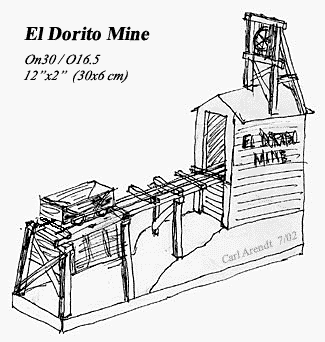 Perhaps the smallest layout in this Gallery, El Dorito Mine was designed as an automated shelf toy, to delight children of all ages who love to watch it work. It provides continuous action and an extremely simple track plan!
Perhaps the smallest layout in this Gallery, El Dorito Mine was designed as an automated shelf toy, to delight children of all ages who love to watch it work. It provides continuous action and an extremely simple track plan!
Rolling stock is just one bottom-dumping wagon and a very small “critter” (llike a Simplex or a home-made battery loco). The car fills up inside the mine building, from a hidden bunker that loads at the rear roofline.
Then, under automatic shuttle control, the “train” carries its load of mine tailings (unwanted excavated earth and rock) out to the end of the trestle. There, it automatiically dumps its load into the lower bunker. Then the train runs back into the mine building and begins the cycle again. The operator occasionally refills the upper bunker from the lower one.
This operation is completely prototypical — hauling excavation rock and dirt from the mine to a nearby tailings pile. To add animation to this little layout, try automating the elevator lift wheel atop the mine building … it turns in one direction to send the elevator down into the mine, then reverses to bring a load of tailings to the surface. Add a flashing red light when the elevator arrives — and maybe a loud klaxon to emphasize the point.
Action in this mine is continuous!
At Last… a G-scale Micro!
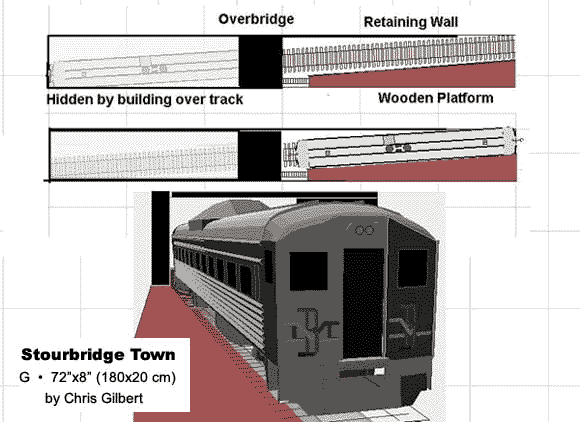
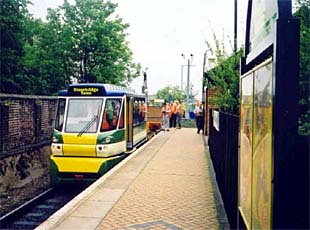 Chris Gilbert has done it again! This time, he’s designed a working G-scale line … in a micro layout size of four square feet! Stourbridge Town is a working layout, accurately reflecting its prototype, in a space of only 72×8 inches!
Chris Gilbert has done it again! This time, he’s designed a working G-scale line … in a micro layout size of four square feet! Stourbridge Town is a working layout, accurately reflecting its prototype, in a space of only 72×8 inches!
The prototype, Chris’s “local” branch line, shuttles from Stourbridge Town down to Stourbridge Junction — under a mile away — up to 60 times a day, every 10 minutes or so. Chris has chosen to use a North American Budd RDC car — measuring nearly three feet in G — as his rolling stock.
The layout, shown above, models the Stourbridge Town platform (photo at right), from which the RDC disappears under an overbridge. Under automatic train control, it pauses for a time in the hidden half of the layout, then reemerges at the platform, where it pulls in and pauses again. Then repeats.
Completely prototypical operation — repeated as often as desired, in full G scale, in the space of a long bookshelf … what more could one ask?
The interesting looking vehicle at the Stourbridge Town platform in the photo is an experimental flywheel-driven light rail vehicle being developed by Parry People Movers Ltd. It runs on the branch on Sundays.
Take a Long Ride…

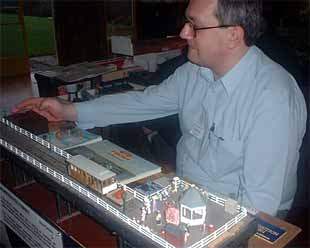 Recreating long-ago seaside holidays is the magic of Walmington Pier, a British HO layout which exactly reproduces the push-pull operation of a typical English seaside resort and pier in the Edwardian era, early in the Twentieth Century. Dave Carson (pictured at right), from Chelmsford, created the layout and has exhibited it widely in England.
Recreating long-ago seaside holidays is the magic of Walmington Pier, a British HO layout which exactly reproduces the push-pull operation of a typical English seaside resort and pier in the Edwardian era, early in the Twentieth Century. Dave Carson (pictured at right), from Chelmsford, created the layout and has exhibited it widely in England.
The complex track plan is shown above. The tram car is an “Anglicised” version of the Bachmann San Francisco cable car in HO scale. As reworked by Dave, it’s a close copy of a “winter car” used on the well-known pier at Southend-on-Sea, which is the world’s longest and busiest.
In his day job, Dave works at a considerably more complex bit of trackage — he’s a manager for Metronet Rail SSL Ltd (formerly London Underground) based in the train yard at the east end of the District Line. He comments, “We stable 29 trains every night on seven single-train-length shed roads and 13 double-train-length yard roads, all fanning off three reception roads. This is my other layout, and it occupies 48 acres!”
UPDATE (25 August 2004)
Dave was recently promoted away from Upminster Depot to become a Supplier Auditor based at HQ in Holborn but travelling around the UK inspecting train equipment suppliers’ quality systems.
For more information about the fascinating pier railways of England, I can heartily recommend the Oakwood Press book, Pier Railways & Tramways of the British Isles, by Keith Turner, ISBN 0-85361-541-1. For more information about Dave Carson’s enchanting model pier, see Model Trains International magazine, issues #34. 36 and 42. Photos are by Greg Dodsworth.
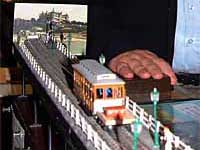

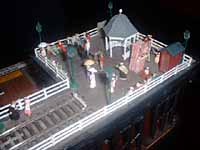
How They Load Beer at Coors
Mike McLaughlin, from Denver, Colorado, recently sent me a very unusual layout idea. Mike wrote:
“I worked in the transportation department at Coors Brewing Co. in the early 70s and they had (still have) a unique system for loading box cars with beer. A railroad track served 7 loading doors on one side of the warehouse and 6 doors on the other. A set of two transfer tables served each door so that individual cars could be spotted and pulled as required.
“The ‘inside’ table would hold a 60′ RBL car next to the loading door, and upon completion of loading, the table would be run out from the door to push out the ‘outside’ table that was aligned with the switching lead and align itself with the lead, allowing the load to be pulled by a switch crew. An empty was then spotted on the ‘inside’ table, which was returned to the door, pulling the “outside” table back into alignment with the lead.”
To clarify the operation, Mike drew up a micro-sized version of this lashup, called A Pony Keg of Coors.
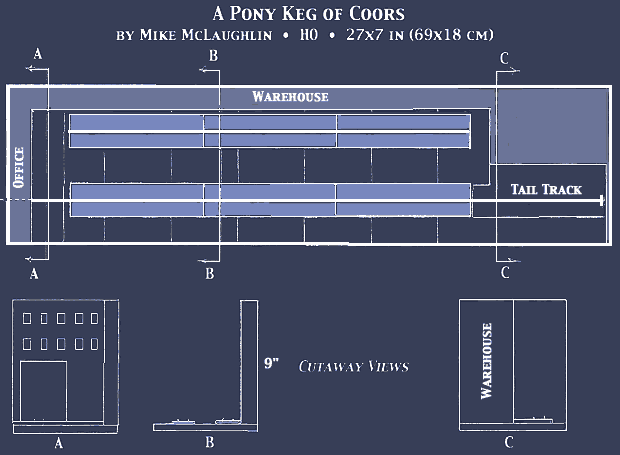 Selective compression has reduced the number of loading doors to three. The switching track enters from a hidden cassette at the left, passes the three loading doors on the “outside” transfer tables, and culminates at the end of the one-car “tail track”. Operation closely matches the prototype.
Selective compression has reduced the number of loading doors to three. The switching track enters from a hidden cassette at the left, passes the three loading doors on the “outside” transfer tables, and culminates at the end of the one-car “tail track”. Operation closely matches the prototype.
Mike again: “The catch is that not all cars were loaded at the same rate. Most product was loaded directly off the production lines, but some product was only run say one or two shifts per day (quarts, 8 oz, etc.) while kegs came from a different part of the brewery. A ‘mixed’ car might be loaded in 3 hours, while a ‘straight’ car of 12oz cans would take less than an hour (7200 cases per car — at a six-pack per day, it’d take you almost 79 years to drink it all!) Thus the crews had to very carefully plan their spotting sequence so that they didn’t have to run to the yard to get rid of their loads before all their empties had been spotted.”
Believe it or not, Mike designed a very ingenious scheme of rods, slots, and catches, which would allow the layout operator to run each door from a single pull-rod and work very much like the prototype tables. The scheme is too complicated to illustrate here — if you’re seriously interested, email me and I’ll email back Mike’s description and diagrams.
Why “A Pony Keg of Coors?” Because the layout is designed to be 9″ high, and the volume of the pike — 7″x27″x9″ — is almost the same as the volume of a pony (half) keg of beer — 7.875 gallons! Needless to say, it weighs considerably less.
Well, as you might expect, I couldn’t resist this one! I immediately set pencil to paper and designed a larger version for O-scale operation using 40-foot reefers and a small switch engine, like a four-wheeled diesel or a 44-tonner. And for simplicity, I reduced the transfer-table count to one per door with two tracks on the table. Here’s the result, A Keg of Coors.
 Operation is much the same as above, with each traverser being pushed and pulled by rods fed through the layout side, either at the front or the rear. Trains enter beneath an office wing which conceals a cassette that holds the switch run’s consist. Again, the challenge is that not all doors will be ready for switching at the same time. A form of random choice (such as pulling cards from a hat) can determine the sequence of loading and spotting of empties, and the crew will have its hands full on every trip from the yard to the brewery!
Operation is much the same as above, with each traverser being pushed and pulled by rods fed through the layout side, either at the front or the rear. Trains enter beneath an office wing which conceals a cassette that holds the switch run’s consist. Again, the challenge is that not all doors will be ready for switching at the same time. A form of random choice (such as pulling cards from a hat) can determine the sequence of loading and spotting of empties, and the crew will have its hands full on every trip from the yard to the brewery!
Unlike most micro layouts, this one might be a good bet for timetable operation. With a fast clock (running, say, five minutes to the hour) a random drawing could determine the time when each car would be loaded and pushed out to the switching track. The railroad crew would really have to be alert to make sure it didn’t get trapped or bottlenecked.
The layout might look something like this:
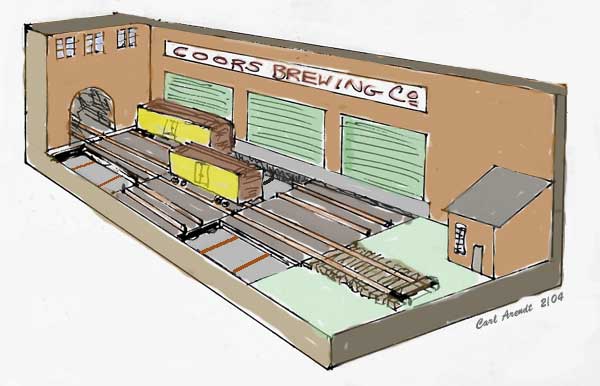 Needless to say, the name comes from the fact that this layout, at 51″x9″x10″ comes very close to the volume of a keg of beer — 15.75 gallons. Thus: A Keg of Coors. Skoal! And many thanks to Mike McLaughlin, who put considerable time and effort into figuring out ways to duplicate the unique Coors loading system in model form (and taught me how to measure layout volumes in kegs and barrels)!
Needless to say, the name comes from the fact that this layout, at 51″x9″x10″ comes very close to the volume of a keg of beer — 15.75 gallons. Thus: A Keg of Coors. Skoal! And many thanks to Mike McLaughlin, who put considerable time and effort into figuring out ways to duplicate the unique Coors loading system in model form (and taught me how to measure layout volumes in kegs and barrels)!
A Tramway to Cuddle!
Let me hasten to add, “Cuddle” is the name of a place on the South Coast of England where shale is quarried and processed to extract the shale oil, which is put up in barrels and shipped to markets around the world. This activity has been going on for some 400 years at Cuddle.
Andy Anderson, who lives in Southampton, has taken that simple outline, imagined a tramway to serve the industrial process, and then created what is to me a brand new operating idea: switching “loads” instead of “wagons” or “cars”! For details, you really need to consult Andy’s website, but here is his sketch of the resulting layout plan.
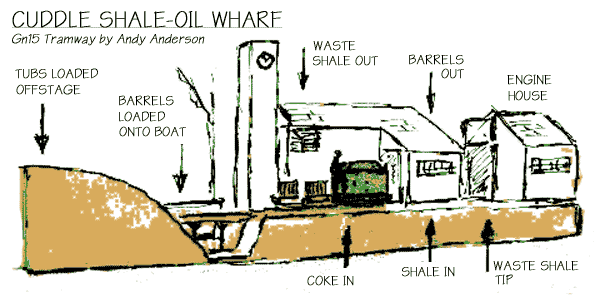 Cuddle Shale-Oil Wharf is 36 inches long (90 cm). It’s a completely straight piece of track, without turnouts. By cunningly “folding” the process back on itself, Andy has managed to model the entire procedure of extracting and shipping shale oil, and placed it on this single wharf scene.
Cuddle Shale-Oil Wharf is 36 inches long (90 cm). It’s a completely straight piece of track, without turnouts. By cunningly “folding” the process back on itself, Andy has managed to model the entire procedure of extracting and shipping shale oil, and placed it on this single wharf scene.
At the center of the pier and its activity is the Retort House, based on an actual structure featuring a modelgenic clock tower, where the shale is “cracked” in retorts fueled by coke. The resulting barrels of oil are hauled by rail to the boats for shipment. The waste product, spent shale, is discarded and taken by rail to the spoils tip for dumping. All of this loading and hauing is performed by the Gn15 tramway, which also has an Engine House at the end of the pier to store its small but strong diesel locomotive.
Here’s Andy’s description of the switching game that results from modeling this industrial process, switching and transporting flatcar loads (referred to as tubs):
“Coke and shale are loaded into tubs offstage (at left, behind a rise in the landscape) and placed on the flats. These are taken to the retort house and loaded into the appropriate places. Waste is discharged from the retort house into empty tubs to be taken to the tailings (waste shale tip) whilst product, in small barrels, is loaded onto flats to be taken to the boat.
“The ‘puzzle’ comes as follows: The ‘coke/waste’ tubs are loose filled, whereas the ‘shale’ tubs are permanently loaded and disappear into the retort (to be carried behind the scenes back to the loading area). On average, an operator picking up two flats in the loading area will receive one tub of each type, but sometimes will get two of one or two of the other. The retort house takes equal quantities and disgorges one waste and one product in return.
“Shale tubs disappear into the retort house leaving an empty flat for carrying barrels. Coke tubs are emptied but remain on the flat and can be refilled with waste for disposal. The operator can return one, two or zero empty tubs in return for a new load. Everything should be balanced, and there is space opposite the retort-house for storing the spare tubs (probably four).
“The degree of difficulty can be controlled by:
allowing a margin for error on the 50:50 loading of the retort house, permitting an operator to get one or two tubs of either type in excess of the other;
reducing the amount of storage space opposite the retort-house, blocking one or more bays with ‘carelessly’ placed piles of rubbish; or
blocking the last five feet of line so that only the flat car nearest the loco can be used for product/waste runs.
‘”The game ends when the operator is expected to make a waste run and has no empty tub available, or when the operator runs out of storage space and either is outside the acceptable ‘mix’ in the retort house or is expected to make a ‘product’ run next.”
Andy has an engineering bent and plans to use a computer program to create random scheduling of the loads and productions, but these could be drawn from a hat, selected by using a spinner, or chosen by rolling dice or drawiing from a shuffled deck of cards.
I think Andy Anderson is onto something here, and I’m sure many industrial processes could be simulated or modeled using similar approaches. If the idea appeals to you and you work out your own version of this theme please let me know, and we’ll add it to the Micro Layout Design Gallery collection.
UPDATE — Andy Mocks it Up (October 2004)
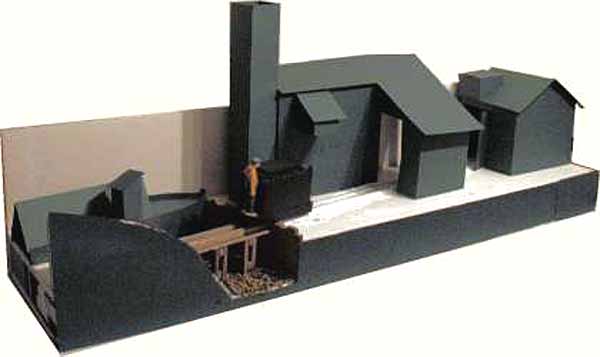
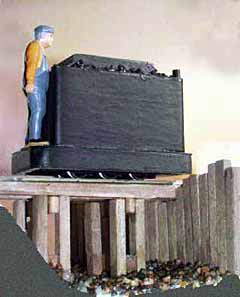 After much travail (on other projects), Andy Anderson has created a mockup of Cuddle Shale-Oil Wharf using wood strips and card. An overview of the mockup in action is shown above. As usually happens, he has learned a lot from making this full-sized version — and has made several changes in his original design as a result.
After much travail (on other projects), Andy Anderson has created a mockup of Cuddle Shale-Oil Wharf using wood strips and card. An overview of the mockup in action is shown above. As usually happens, he has learned a lot from making this full-sized version — and has made several changes in his original design as a result.
You can read full details in his Cuddle website.
At left is a trial photo of yet another mockup — a loco for Cuddle, based on general outlines of the Guinness Brewery narrow-gauge locos in Dublin (see John Glenn’s loco drawing at his Guinness track plan). This version has no details as yet, but shows that the body shape will nicely accommodate the mechanism.
Next step: building the thing. Stay tuned!
Leave a Reply